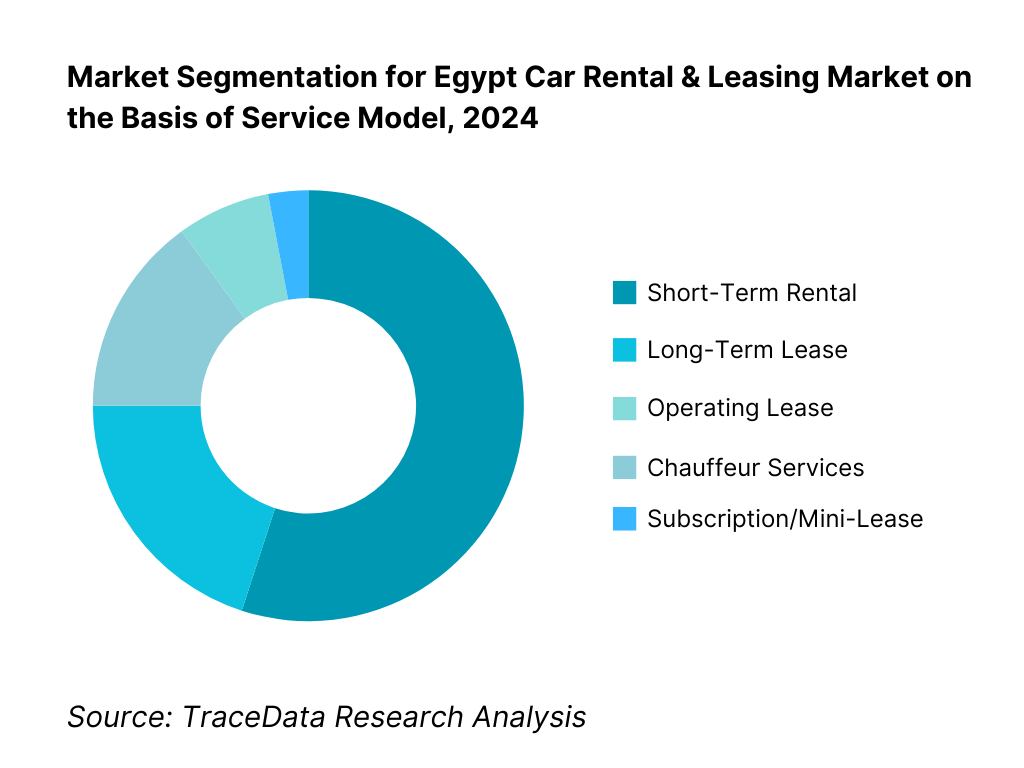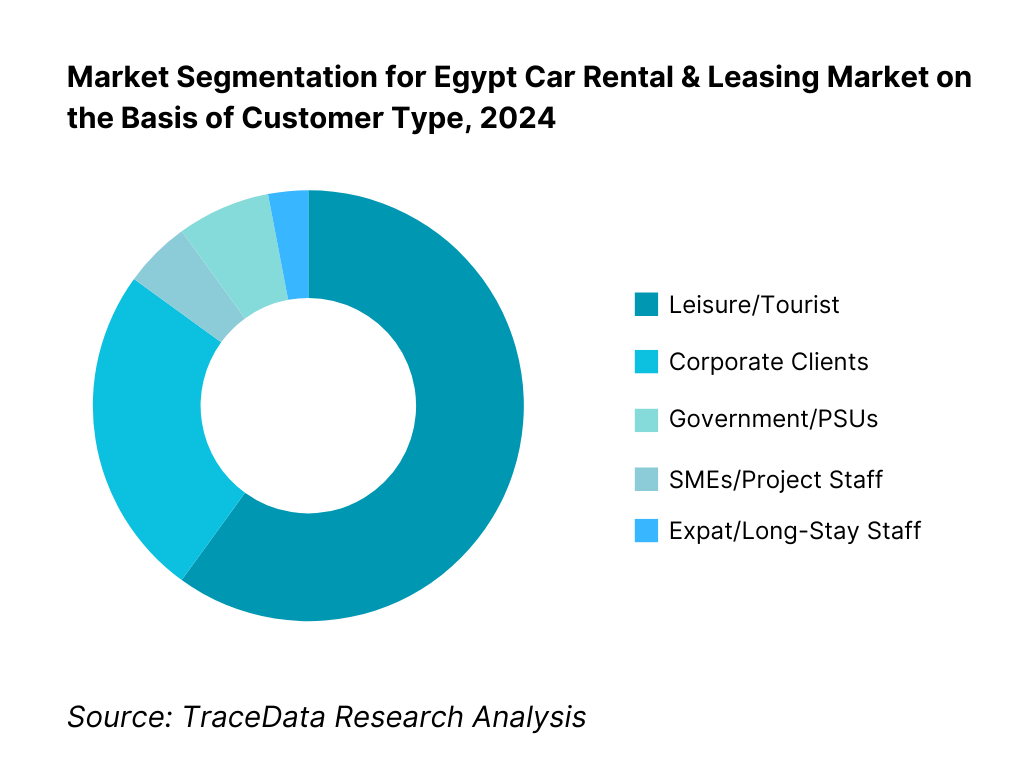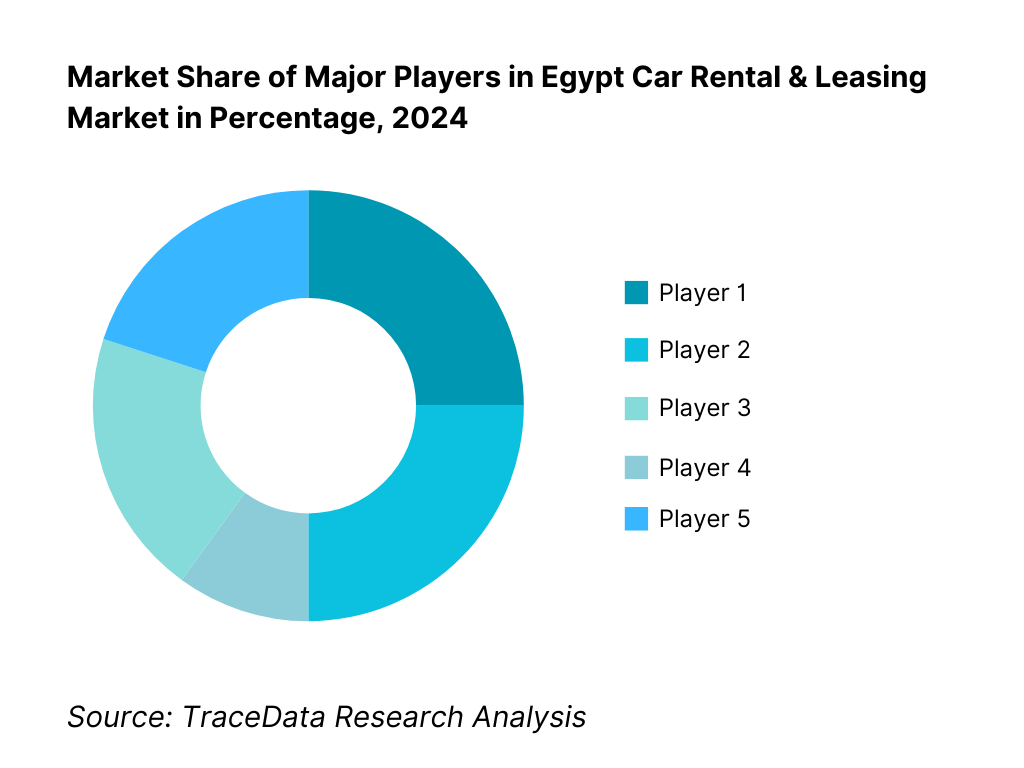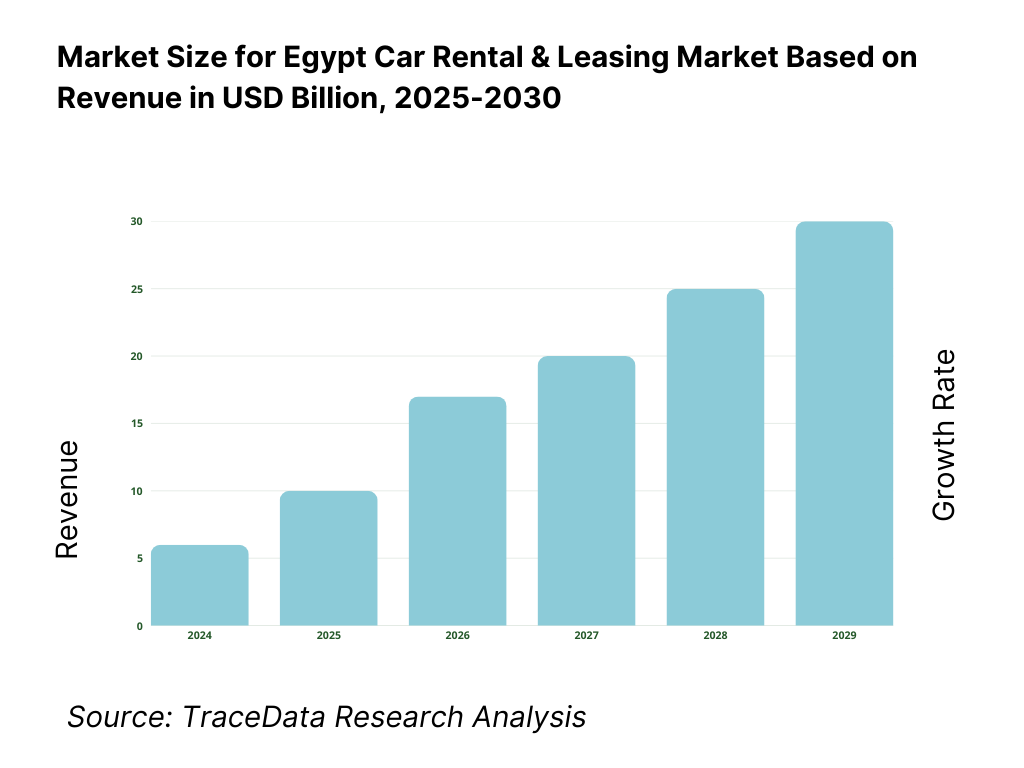Egypt Car Rental & Leasing Market Outlook to 2030
By Service Type, By Customer Type, By Booking Channel, By Vehicle Class, By Tenure, and By Region
- Product Code: TDR0243
- Region: Asia
- Published on: August 2025
- Total Pages: 110
Introducing the World's FirstPay-Per-Section Market Reports
Why pay for the full report when you need just a part?
Start Building Your Report
Scroll down to see available sections
Report Summary
The report titled “Egypt Car Rental & Leasing Market Outlook to 2030 — By Service Type, By Customer Type, By Booking Channel, By Vehicle Class, By Tenure, and By Region” provides a comprehensive analysis of Egypt’s mobility rental ecosystem. It covers the overview and genesis of the industry, overall market size in terms of revenue, and a detailed market segmentation. The report maps trends and developments, the regulatory landscape, and customer-level profiling. It evaluates issues and challenges and the competitive landscape including competition scenario, cross-comparison, and company profiling of major operators. Finally, the study presents future market projections to 2029 based on fleet units, utilization, ADR/yield corridors, service-mix evolution and regional demand nodes, supported by cause-and-effect relationships. It highlights opportunities and bottlenecks, and includes success case studies, concluding with opportunity matrices and cautionary notes for investors, operators, OEMs, financiers, and policy stakeholders.
Egypt Car Rental & Leasing Market Overview and Size
The Egypt Car Rental & Leasing market is valued at approximately USD 117.23 million, supported by industry-standard estimates, and is propelled by a robust rebound in inbound tourism (15.8 million visitors in the latest measurement) and an expanding urban middle class seeking flexible, asset-light mobility solutions. This market size reflects a strong baseline for both short‑term rentals and long‑term leasing services across leisure and corporate segments.
Dominant urban centers such as Cairo and Red Sea resort hubs (e.g., Hurghada, Sharm El‑Sheikh) lead the market due to their high concentration of airport arrivals, tourist inflows, and corporate activity, creating dense demand for rental services. Their infrastructure, international connectivity, and hospitality sectors drive elevated usage, reinforcing their dominance.

What Factors are Leading to the Growth of the Egypt Car Rental & Leasing Market:
Tourism-led mobility demand and strong air connectivity: Egypt’s inbound tourism hit 14.906 million arrivals, driving short-term rentals at gateway cities and leisure destinations. Airside throughput rose to 47 million passengers across Egyptian airports, led by 26 million at Cairo International, 8.7 million at Hurghada and 5.9 million at Sharm El-Sheikh—sustaining on-airport rental counters and chauffeur pick-ups. Early 2024 traction (2.12 million arrivals in the first two months) signals continued airport-origin demand for self-drive and with-driver rentals, while diversified gateways (e.g., Borg El Arab ~2 million passengers) help spread fleet deployment. Car rental/leasing operators benefit directly from flight-to-keys conversion ratios on inbound itineraries (airport arrivals, hotel staging, inter-city trips).
Lodging capacity additions unlock more pick-ups and longer holds: Room supply expanded by 14,209 hotel rooms (Dec-to-Dec), with additional 4,012 rooms in Q1 and further openings ~1,245 rooms across Cairo, Red Sea, South Sinai and Luxor—expanding the number of pick-up points and corporate-rate properties that require on-premise mobility partners. Airports underpin this footprint: 47 million total passengers, with 26 million at CAI and 8.7 million HRG, translate into higher rental-desk footfall and stronger weekly utilization. New rooms in resort markets lift demand for SUVs/MPVs and with-driver services for airport-to-resort transfers, while Cairo’s city-center openings increase weekday corporate leasing rotations.
Large domestic market and macro tailwinds for corporate mobility: Egypt’s population reached 116,538,258, anchoring recurring domestic travel and replacement-cycle leasing. On the macro side, GDP at current prices stood at USD 389.06 billion, supporting corporate fleets in construction, FMCG distribution, pharma detailing and field services. Urban concentration around Greater Cairo—~45% of urban population in the largest city—keeps demand dense for daily rentals, last-mile logistics vans and long-term operating leases. Capital inflows also reinforce vehicle availability: European firms announced over €40 billion in potential agreements across energy, construction, chemicals, shipping and aviation, adding mobility demand from project crews and visiting teams. Together these numeric fundamentals point to sustained multi-segment utilization across short-term rentals and contracts of 12–48 months.
Which Industry Challenges Have Impacted the Growth of the Egypt Car Rental & Leasing Market:
Cost of capital and financing pressure on fleet expansion: The Central Bank of Egypt’s Monetary Policy Committee lifted rates in a special meeting, setting the overnight deposit at 27.25 and lending at 28.25, then kept them unchanged in May. These high nominal benchmarks elevate lease funding costs and extend payback periods on imported vehicles, which are typically financed via EGP loans indexed to central rates. Elevated rates also cascade into higher collateral and insurance requirements for SME lessees, tightening underwriting filters and slowing new-contract growth. For rental operators, working capital lines priced off the 27.75 main operation rate constrain fleet refresh cycles, while OEM delivery schedules remain sensitive to FX cash-flow timing.
Fuel price adjustments increase operating expenses: Egypt’s Fuel Automatic Pricing Committee raised pump prices, setting 95-octane at EGP 13.50/L, 92-octane at EGP 12.50/L, 80-octane at EGP 11.00/L and diesel at EGP 10.00/L (with subsequent quarterly reviews). These concrete price points feed directly into per-day operating costs, shuttle services and chauffeur products, while also impacting airport-to-city transfer pricing and long-distance one-way rentals. The same decision fixed car fuel gas at EGP 6.50/m³ and butane at EGP 100/cylinder—relevant to mixed-fuel fleets and depot operations. Higher fuel outlays compress margins unless offset via utilization gains, mileage caps, or recalibrated protection packages.
Demand concentration and seasonality risk across gateways: Airport traffic is skewed toward Cairo and Red Sea hubs, with 26 million passengers at CAI versus 8.7 million at Hurghada and 5.9 million at Sharm El-Sheikh out of 47 million total, necessitating uneven fleet allocation and repositioning costs. Cultural-heritage and sun-and-sea itineraries swing heavily by season, with inbound arrivals reaching 14.906 million and clustering around school holidays and winter months—raising the risk of idle assets off-season and vehicle scarcity in peaks. Operators must balance one-way surcharges, inter-city logistics and strategic pooling, especially when hotel-centric markets see bursts linked to room additions and charter schedules.
What are the Regulations and Initiatives which have Governed the Market:
Financial leasing framework under FRA (Law No. 176/2018) anchors corporate vehicle leasing: Egypt’s Financial Regulatory Authority oversees leasing and factoring pursuant to Law 176/2018, licensing market participants and setting prudential rules that govern operating leases widely used for fleet financing. FRA reports 49 licensed financial leasing companies by end-year, alongside 39 factoring companies, providing the legal infrastructure for long-term vehicle contracts to corporates and SMEs. FRA’s ongoing disclosures on non-bank financing volumes and contract counts give lessors and operators a rule-bound context for vehicle procurement, repossession, and risk transfer—critical for multi-year mobility agreements.
VAT regime—standard rate and digital compliance obligations affect pricing and platforms: The Egyptian Tax Authority sets a 14% standard VAT rate under Law 67/2016 (and executive regulations), applicable to domestic car rental and lease services. For platform-enabled rentals and ancillary digital services (e.g., app-based add-ons, e-invoicing), the ETA’s digital/remote services guidelines introduce a simplified registration path for non-resident vendors with a EGP 500,000 turnover threshold (12-month window), shaping cross-border platform operations and tax collection on B2C supplies. These numeric rules inform tax-inclusive pricing, receivables management and marketplace compliance for aggregator-listed rental brands.
Fuel Automatic Pricing Committee decisions—transparent, quarterly pump-price setting: The Fuel Automatic Pricing Committee reviews domestic fuel prices quarterly, with a decision setting 95-octane at EGP 13.50/L, 92-octane at EGP 12.50/L, 80-octane at EGP 11.00/L, and diesel at EGP 10.00/L, plus car fuel gas at EGP 6.50/m³. Because fuel is a material input to daily rentals, with-driver services and logistics vans, these specific rates are embedded into rate cards, relocation fees and fuel policies. The numeric transparency of the committee’s releases lets operators calibrate surcharges and mileage allowances and negotiate corporate contracts with formula-based pass-throughs.
Egypt Car Rental & Leasing Market Segmentation
By Service Model: The Egypt car rental & leasing market is segmented into short-term rental, long-term lease, operating lease (corporate lease), chauffeur/with-driver services, and subscription/mini-lease. Short-term rental dominates, capturing more than half of revenue, driven by high tourist demand at airport stations, strong walk-in and OTA bookings, and the prevalence of asset-light travel behavior. Tourists and business visitors favor flexibility without long-term commitments, boosting this sub-segment’s share significantly.

By Customer Type: Within Egypt’s car rental & leasing market, leisure/tourist customers hold the largest share due to the steady recovery and growth of international arrivals, especially in resort hubs. The ease of booking, preference for self-drive for sightseeing, and high visitation numbers sustain this lead. Corporate clients form the next largest portion, supported by long-term rental contracts and leasing solutions for business travel and mobility programmes.

Competitive Landscape in Egypt Car Rental & Leasing Market
Egypt’s car rental & leasing market is moderately consolidated, with international franchise brands and strong local players shaping competitive dynamics. Egypt’s market shows a blend of international brand strength (Avis, Hertz, SixT) and agile local operations (Green Motion, GB Auto Rental). ADR (average daily rate) indicates slightly premium pricing by SIXT, while Green Motion positions competitively. Online booking share varies; convenience and digital UX remain key differentiators.
Name | Founding Year | Original Headquarters |
Avis | 1946 | Ypsilanti, USA |
Budget | 1958 | Los Angeles, USA |
Hertz | 1918 | Chicago, USA |
SIXT | 1912 | Munich, Germany |
Europcar | 1949 | Paris, France |
Enterprise Rent-A-Car | 1957 | St. Louis, USA |
National Car Rental | 1947 | St. Louis, USA |
Alamo Rent A Car | 1974 | Orlando, USA |
Payless Car Rental | 1971 | Spokane, USA |
Green Motion | 2007 | Princes Risborough, UK |
Autounion Car Rental | 2003 | Athens, Greece |
GB Auto (GB Corp) | 1960 | Cairo, Egypt |
Ezz Elarab Automotive | 1975 | Giza, Egypt |
Trust Car Egypt | 2005 | Alexandria, Egypt |
GB Lease & Factoring | 2008 | Mohandessin (Giza), Egypt |
Some of the Recent Competitor Trends and Key Information About Competitors Include:
Avis Egypt: As one of the oldest international rental brands operating in Egypt, Avis expanded its airport fleet capacity in Cairo and Hurghada in 2024, focusing on premium and SUV categories to cater to high-spending inbound tourists. The brand has also strengthened its loyalty program integrations with airline partners.
Budget Egypt: Known for its strong economy car positioning, Budget has increased its partnerships with online travel agencies, resulting in a noticeable rise in OTA bookings. The company has also introduced bundled protection products to attract cost-sensitive customers who still seek comprehensive coverage.
Hertz Egypt: With a strong corporate and leasing portfolio, Hertz has enhanced its long-term rental solutions for SMEs and multinational firms. In 2024, it rolled out new digital booking features with instant confirmations for corporate accounts, streamlining mobility for business travelers.
SIXT Egypt: Specializing in premium and luxury vehicles, SIXT expanded its fleet of high-end SUVs and sedans in Cairo and Sharm El-Sheikh. The operator has positioned itself as a preferred choice for corporate executives and affluent tourists, with chauffeur services becoming a growing part of its offering.
Green Motion Egypt: Focusing on eco-friendly mobility, Green Motion has introduced hybrid and electric vehicle pilots into its Cairo and Hurghada fleets in 2024. The company is also leveraging its sustainability branding to appeal to European tourists seeking green travel options.

What Lies Ahead for Egypt Car Rental & Leasing Market?
The Egypt car rental & leasing market is set for steady expansion over the next several years as inbound tourism remains robust, airport throughput at Cairo/Red Sea hubs keeps climbing, and corporates continue outsourcing mobility instead of owning fleets. Digital booking penetration via OTAs and direct apps will keep raising conversion and utilization, while the FRA-supervised non-bank finance ecosystem enables operating-lease growth for SMEs and large enterprises. Together, these forces point to broader service mixes (short-term, long-term, chauffeur, subscription) and healthier asset productivity across peak and shoulder seasons.
Rise of Hybrid Mobility Models: The next phase will blend short-term rental, flexible long-term rental, subscription/mini-lease, and chauffeur/with-driver into unified offers. Airport counters and hotel desks will coexist with contactless pickup and on-demand delivery, letting operators rebalance fleets between Cairo business demand and Red Sea leisure surges. Subscription products with easy swap/upgrade options and mileage bundles will appeal to expats, contractors, and SMEs, while chauffeur services scale for MICE and executive travel. These hybrids smooth seasonality, lift utilization, and open new price points without locking customers into traditional leases.
Focus on Outcome-Based Corporate Mobility: Corporate buyers will push for SLAs around uptime, replacement vehicles, roadside response, and digital reporting rather than purely daily rates. Expect tighter KPIs—vehicle availability windows, incident response times, and fuel/mileage analytics—baked into contracts, with penalty/bonus mechanisms. Operators that package dashboards, e-invoicing, duty-of-care protocols, and telematics-driven driver safety scores will win multi-year frameworks. This outcome focus also supports TCO-based proposals (maintenance, tires, insurance, downtime) and strengthens renewal odds when FX and fuel costs fluctuate.
Expansion of Sector-Specific Leasing: Energy, construction, logistics, hospitality, healthcare, and ICT will increasingly demand bespoke fleets—SUVs and pickups for sites, MPVs for crew shuttles, cold-chain vans for pharma, executive sedans for hotels and corporates. Sector playbooks will standardize vehicle specs, upfitting, and maintenance cycles, while buyback/RV-guarantee structures from OEMs reduce disposal risk. In resort markets, hotels and DMCs will anchor with-driver contracts for airport transfers and tours, whereas Cairo’s corporate core will favor operating leases with quarterly utilization reviews and flexible swap rights.
Leveraging AI, Telematics & Analytics: Competitive advantage will hinge on data. Dynamic pricing engines will optimize ADR by micro-location, arrival banks, and weather/events; telematics will monitor driver behavior, idling, and fuel to curb loss ratios; and AI-assisted claims triage will cut damage cycle times. Fraud controls (document checks, deposit logic, chargeback defenses) and predictive maintenance will reduce downtime. Seamless stacks—apps, web, OTA APIs, and e-KYC—will shrink booking friction, while analytics unlock smarter repositioning between airport and city branches, lifting both utilization and customer satisfaction.

Egypt Car Rental & Leasing Market Segmentation
By Service Type (in value/volume %)
Short-Term Self-Drive (daily/weekly)
Long-Term Rental (monthly/quarterly)
Operating Lease (contracted fleets)
Finance Lease (asset ownership at term end)
Chauffeur / With-Driver Services
Subscription / Mini-Lease (flexi-tenure)
By Customer Type
Corporate & Enterprise Accounts (framework contracts, SLAs)
Leisure/Tourist (airport/resort demand)
Government & Public Sector (ministries, agencies, PSUs)
SMEs & Project-Based Contractors (site mobility)
Expat/Long-Stay & Relocation
MICE/Events (conference & group movements)
By Booking Channel
Direct Digital (brand website, mobile app, call center)
OTA/Aggregators & Metasearch (Rentalcars, Kayak, Skyscanner, etc.)
Corporate/TMC & GDS (managed travel programs)
Walk-in/Counter (airport & downtown branches)
Hotel/Airline Desks & Concierge Partnerships
By Vehicle Class
Economy/Compact (A–B segment hatchbacks/sedans)
Mid-Size (C–D segment sedans)
SUV/Crossover (2WD/4WD, resort/city mix)
Premium/Luxury (executive sedans, performance)
Vans/People Movers (7–15 seaters)
EV/Hybrid (battery electric, hybrid)
By Geography / Location Cluster
Greater Cairo (airport & city hubs)
Red Sea Resorts (Hurghada, Sharm El-Sheikh)
Alexandria & North Coast (ALY, coastal tourism/corporate)
Upper Egypt (Luxor, Aswan; heritage circuits)
Sinai & Canal Cities (Port Said, Ismailia, Suez)
New Administrative Capital / Satellite Cities
Players Mentioned in the Report:
Avis Egypt
Budget Egypt
Payless Egypt
Hertz Egypt
SIXT Egypt
Europcar Egypt
Enterprise Rent-A-Car Egypt
National Car Rental Egypt
Alamo Egypt
Green Motion Egypt
Autounion Car Rental Egypt
GB Auto Rental
Ezz Elarab – Rent & Lease
Trust Car Egypt
GB Lease & Factoring
Key Target Audience
Fleet investors and leasing finance companies
International and local airport concession planners
Hotel chains and tour operators
Airlines and airport authorities
Investments and venture capitalist firms
Government and regulatory bodies
Vehicle OEMs and dealership groups
Corporate travel managers at large enterprises
Time Period:
Historical Period: 2019-2024
Base Year: 2025
- Forecast Period: 2025-2030
Report Coverage
Choose individual sections to purchase. Mix and match as you like.
- -
- -
- $100
4.1. Delivery Model Analysis [Short-Term Rental, Long-Term Lease, Operating Lease, Finance Lease, Chauffeur/With Driver, Subscription]-Margins, Preference, Strengths, Weaknesses
4.2. Revenue Streams for Egypt Car Rental & Leasing Market [Base Rate, Mileage, Ancillaries, Fuel Policies, Protection Products, Chauffeur Fees, Subscription Revenues]
4.3. Business Model Canvas for Egypt Car Rental & Leasing Market [Key Partners, Value Propositions, Customer Segments, Channels, Revenue Streams, Cost Structure]
$2505.1. International Franchise vs Local Operators
5.2. Investment Model in Egypt Car Rental & Leasing [Franchise Fee, Fleet Financing, Airport Concession Investments]
5.3. Comparative Analysis of Customer Funnel by Corporate, Tourist, and Government Clients
5.4. Corporate Mobility Budget Allocation by Company Size [Large Enterprises, SMEs, Project-Based Contractors]
$1506.1. Airport vs Downtown Nodes
6.2. Red Sea Resorts vs Cairo Corporate Market
6.3. Segment Profitability & Yield Mapping
6.4. White-Space Opportunities
$1007.1. Fleet Adequacy vs Seasonal Tourism Peaks
7.2. Gaps in Premium/SUV/EV Segments
7.3. Regional Coverage Gaps in Secondary Cities
$2008.1. Revenues (EGP Bn / USD Bn)
8.2. Fleet Size & Utilization %
8.3. ADR & RevPAC Analysis
$3009.1. By Market Structure [Rental, Operating Lease, Finance Lease, Chauffeur]
9.2. By Service Type [Short-Term, Long-Term, Subscription, With Driver]
9.3. By End-User [Corporate, Tourist/Leisure, Government, Expat/Project Staff, SMEs]
9.4. By Vehicle Class [Economy/Compact, Mid-Size, SUV, Luxury, Vans, EV/Hybrid]
9.5. By Booking Channel [OTA, Direct, TMC/Corporate Contracts, Walk-in/Desk]
9.6. By Location Cluster [Greater Cairo, Red Sea Resorts, Alexandria, Upper Egypt, Canal Cities]
$40010.1. Corporate Client Landscape & Cohort Analysis [Sectors: Energy, Construction, ICT, FMCG]
10.2. Tourist & Expat Demand Funnel [Inbound Arrivals, ADR by Source Market, Resort Seasonality]
10.3. Decision-Making Process for Corporate & Government Contracts
10.4. ROI Analysis for Corporate Fleet Outsourcing & Leasing Models
10.5. Gap Analysis Framework
$50011.1. Trends & Developments [Contactless Rentals, OTA Penetration, EV Pilots, Dynamic Pricing]
11.2. Growth Drivers [Tourism Arrivals, Urbanization, Corporate Outsourcing, Ride-Hailing Substitution]
11.3. SWOT Analysis for Egypt Car Rental & Leasing Market
11.4. Issues & Challenges [EGP Volatility, Import Duties, Insurance Cost, Residual Value Risk]
11.5. Government Regulations [FRA Leasing Law, Licensing, Airport Concession Norms, Insurance Mandates]
$20012.1. Market Size & Future Potential for Online Car Rentals in Egypt
12.2. Business Model & Revenue Streams of OTAs/Aggregators
12.3. Booking Models [Prepaid vs Postpaid; Direct vs OTA]
12.4. Cross-Comparison of Leading OTAs [Company Overview, Revenues, # of Bookings, Cancellation Rate, Technology Used, Payment Models]
$500- $250
- $150
15.1. Market Share of Key Players [Revenue/Fleet Basis]
15.2. Benchmark of Key Competitors-Company Overview, Fleet Size, Branch Network, Revenues, ADR, Utilization, Booking Mix, Corporate Contracts, Digital Capabilities, Ancillary Revenues, Strategic Partnerships, Recent Developments
15.3. Operating Model Analysis Framework
15.4. Gartner Magic Quadrant [Positioning by Capabilities vs Vision]
15.5. Bowmans Strategic Clock for Competitive Advantage
$75016.1. Revenues (EGP Bn / USD Bn)
16.2. Fleet Growth & Utilization Forecast
$30017.1. By Market Structure [Rental, Lease, Chauffeur, Subscription]
17.2. By Service Type [Short-Term, Long-Term, Corporate Lease, With Driver]
17.3. By End-User [Corporate, Tourist, Government, Expat, SME]
17.4. By Vehicle Class [Economy, SUV, Luxury, Van, EV/Hybrid]
17.5. By Booking Channel [OTA, Direct, Corporate/TMC, Walk-in]
17.6. By Location Cluster [Cairo, Red Sea Resorts, Alexandria, Upper Egypt, Canal Cities]
$400- $250
- $250
Research Methodology
Step 1: Ecosystem Creation
We begin by mapping the entire Egypt car rental & leasing ecosystem, capturing both demand-side and supply-side entities. On the demand side, this includes inbound tourists (14.9 million arrivals), corporates across energy, construction, ICT, FMCG, government fleets, SMEs, and expatriate staff. On the supply side, we identify international franchise operators (Avis, Hertz, SIXT, Europcar, Enterprise/National/Alamo), local providers (GB Auto Rental, Trust Car Egypt, Ezz Elarab Leasing), OTAs/aggregators, OEMs/dealers, financiers, and insurers. Based on this ecosystem, we shortlist 5–6 leading operators in Egypt using parameters such as fleet size, airport presence, revenue footprint, and client base. Data sourcing is conducted through press articles, industry publications, government statistics (tourism, airport traffic, FRA leasing reports), and proprietary company filings to collate sector-wide information.
Step 2: Desk Research
We then engage in exhaustive desk research, drawing from secondary and proprietary databases. This allows us to build a granular understanding of the Egypt car rental & leasing market. We analyze fleet volumes, utilization levels, ADR (average daily rate) patterns, booking channel splits, and corporate leasing penetration. Industry variables such as airport passenger throughput, hotel capacity expansion, vehicle import flows, and financing availability are examined. At the company level, we assess operator revenues, branch footprint, fleet age mix, service portfolios, and digital platforms by reviewing press releases, franchise disclosures, and annual reports of local automotive groups (e.g., GB Auto, Ezz Elarab). This step provides the baseline foundation of industry-level insights and helps map competitive positioning.
Step 3: Primary Research
Following desk research, we conduct in-depth interviews with senior executives of rental & leasing firms, airport concession managers, fleet financiers, and large corporate mobility buyers. The objectives are to validate market hypotheses, authenticate statistical data, and collect operational insights such as average utilization, claims ratios, and corporate contract structures. A bottom-to-top approach is employed—evaluating revenue contributions of each operator and scaling upwards to estimate the market. To strengthen accuracy, disguised interviews are also executed, where our team engages companies as potential clients to validate pricing, fleet economics, and service models. These interactions reveal detailed information on revenue streams (short-term rental, corporate lease, chauffeur), value chain processes (procurement, de-fleet, disposal), and pricing mechanics (daily rate, mileage caps, protection products).
Step 4: Sanity Check
Finally, we perform a top-to-bottom and bottom-to-top analysis to reconcile estimates, ensuring methodological integrity. This includes triangulating fleet size data from airport passenger throughput, hotel room additions, and FRA leasing company disclosures. Market size modeling exercises are stress-tested against operator utilization ratios and average contract values. Any variances between desk research and primary findings are re-validated through follow-up interviews or recalibration of assumptions. This dual sanity check provides a robust and validated market view of Egypt’s car rental & leasing sector.
FAQs
01 What is the potential for the Egypt Car Rental & Leasing Market?
The Egypt car rental & leasing market is poised for steady expansion over the next few years, underpinned by resilient inbound tourism, rising airport throughput at Cairo and Red Sea hubs, and continuing corporate preference for asset-light mobility. Broader hotel capacity additions, new urban corridors (e.g., the New Administrative Capital), and expanding digital distribution through OTAs and brand apps are widening the addressable base. Together, these forces support deeper service mixes—short-term rental, operating lease, chauffeur/with-driver, and subscription—while improving fleet utilization and network productivity.
02 Who are the Key Players in the Egypt Car Rental & Leasing Market?
The competitive field blends international franchises and strong local groups. Prominent names include Avis, Budget, Hertz, SIXT, Europcar, Enterprise (plus National and Alamo), Payless, Green Motion, Autounion, alongside local/leasing operators such as GB Auto Rental, Ezz Elarab Leasing & Rental, Trust Car Egypt, and GB Lease & Factoring. These players anchor airport counters and downtown branches, maintain sizable mixed fleets across economy/SUV/premium classes, run corporate frameworks, and increasingly leverage direct digital channels alongside OTA partnerships.
03 What are the Growth Drivers for the Egypt Car Rental & Leasing Market?
Key demand catalysts include the continued recovery of leisure travel to resort corridors and heritage circuits, which sustains on-airport rentals and with-driver transfers; strong air connectivity that concentrates arrivals into high-yield nodes; and corporate outsourcing of mobility, which favors operating leases and flexible long-term rentals for field teams, executives, and project staff. Digital adoption—contactless pickup, e-KYC, dynamic pricing, and loyalty integrations—raises conversion and utilization, while OEM–financier tie-ups and the FRA-supervised non-bank finance ecosystem support fleet refresh, new product launches (e.g., subscription/mini-lease), and EV/hybrid pilots.
04 What are the Challenges in the Egypt Car Rental & Leasing Market?
Operators face elevated funding costs and FX volatility that complicate fleet procurement and refresh cycles; import duties and homologation timelines can extend vehicle onboarding; and fuel price adjustments pressure operating economics for self-drive and chauffeur products alike. Seasonality and demand concentration around Cairo and Red Sea gateways create repositioning costs and off-peak idle risk. Competitive pressure from ride-hailing and informal operators, plus tightening compliance around VAT, e-invoicing, and airport concession standards, requires sharper revenue management, stricter underwriting, and stronger customer-experience controls.